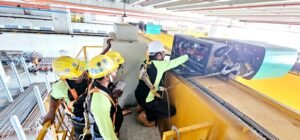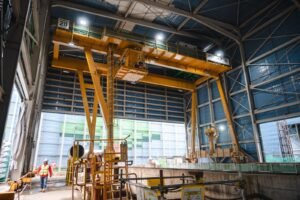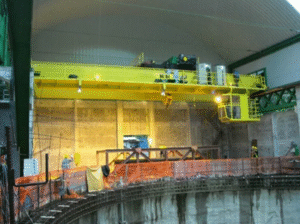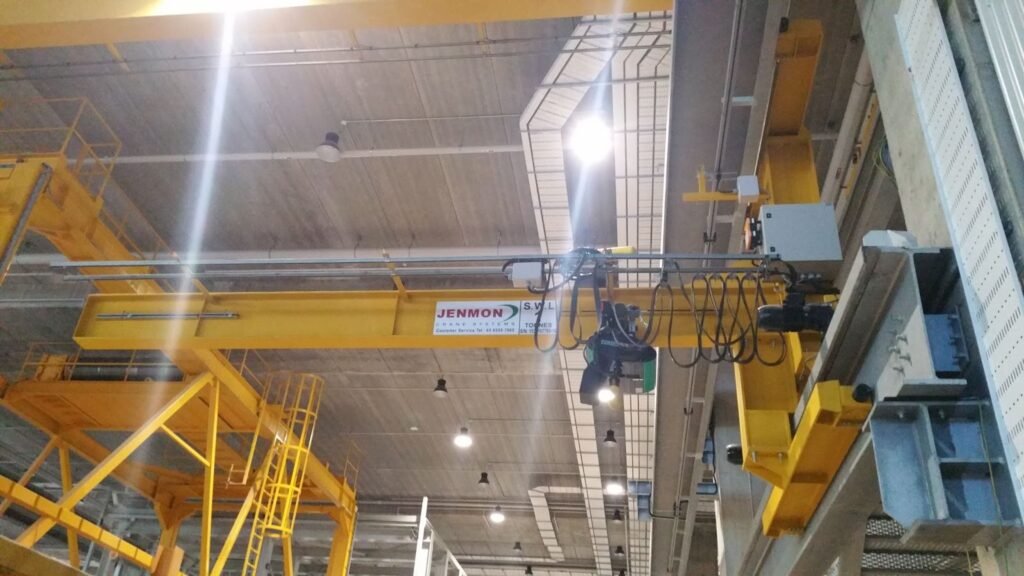Jenmon | Blogs
Common Overhead Crane Part Failures and How to Prevent Them
Overhead cranes act as essential tools in warehouses, manufacturing facilities, and construction areas, transporting heavy items with accuracy and strength. These large machines move tons of steel, concrete, and equipment every day, conserving countless hours of labour. Comprehending the operation of these cranes involves not only efficiency but also safety considerations.
When crane components wear down or malfunction, production halts, repair costs increase, and most critically, employees encounter significant hazards. At Jenmon, we have observed that minor maintenance issues can escalate into significant problems, leading to substantial costs for companies due to downtime and repairs.
Common Overhead Crane Part Failures
1. Worn-Out Wheel bearings and Wheel blocks
In order for your crane to travel smoothly along the runway beams or track, carrying loads throughout your facility or yard, these wheels of the end carriages take a beating. When you notice strange grinding noises, wobbling movements, or the crane struggling to travel in a straight line, you need to attend to it immediately.
These signs scream for attention. Misaligned wheels on the rails create friction that wears down both the wheel blocks and the wheel bearings. Smart owners appoint the crane service provider to check the wheels monthly or regularly, apply lubricant on the wheel bearings regularly, and listen for unusual sounds. Remember, replacing the wheel blocks or wheel bearings is a less expensive way than to change a complete set of end carriage complete with motor and gearbox in the event no maintenance is put in place.
2. Damaged Hoist Mechanism
The hoist does the heavy lifting, raising and lowering loads all day long. Wire rope hoists handle heavier loads and move faster, while chain hoists offer better precision for lighter work. Both need regular checks! Look for frayed wires, stretched links, or worn sheaves. We recommend inspecting wire ropes weekly for broken strands or bird caging (where wires separate and bulge).
Chain hoists need checks for stretched links or twisting. Don’t forget the drum too—cracks or grooves wear spell trouble. Smart maintenance means checking cable festoons for proper tracking and ensuring brake systems engage fully every time.
3. Malfunctioning End Trucks
End trucks connect the bridge to the runway system, letting your crane travel along rails throughout your facility. These sturdy assemblies contain wheels, bearings, and axles that take serious punishment. When end trucks misalign, you’ll notice screeching sounds, uneven movement, or excessive wheel wear and wheel bearings damages.
This misalignment creates dangerous situations where wheels can jump tracks or damage runway rails. Fix this by regularly checking wheel alignments, tightening loose bolts, and examining the flange of the bridge for wear or damage. Smart operators also listen for changes in sound when the crane moves—that grinding noise isn’t normal; it’s a warning sign!
4. Faulty Crane Controls and Electrical Issues
Crane controls give operators precise command over movement—whether using a hanging pendant or wireless remote system. Electrical problems top the list of common failures, from simple power issues to complex intermittent issues when a crane is in operations.
Festoon cables and trolleys often develop problems from constant movement. Trolleys can be jammed together at times and crane operators pulling the hanging pendant may result in bigger issues causing the cables internal wiring damage. Prevent these headaches by testing emergency stops monthly, inspecting all cable connections for tightness, and keeping moisture away from electrical components. Carbon brushes of the collectors require frequent cleaning, as dust accumulation can lead to shorts or connectivity issues.
How to Prevent Overhead Crane Component Failures

1. Routine Inspection and Preventive Maintenance
We can’t stress enough the importance of checking your crane parts regularly. Look at trolley rides, runway connections, and beam joints every week. Daily visual inspections catch problems before they grow. Don’t wait for breakdowns to perform maintenance. Create a checklist and stick to it religiously. Track wear patterns to predict when parts need replacing before they fail. Smart companies schedule quarterly professional inspections alongside daily operator checks.
2. Customising Crane Systems for Specific Needs
One-size-fits-all rarely works with cranes. At Jenmon, we recommend customising your crane system based on actual needs—not just buying the biggest available. Consider load capacity, lifting frequency, and environmental factors like heat or dust. Some operations need a jib crane’s precision, while others require the coverage of a top-running bridge crane. The right setup prevents overworking components and extends equipment life dramatically.
3. Ensuring Proper Load Handling and Operator Training
Even the best crane fails when operated poorly. Teach operators proper load attachment techniques, safe movement speeds, and how to recognise warning signs. Training pays for itself by preventing accidents and extending equipment life. We’ve seen skilled operators spot problems just from subtle changes in crane sounds or movement. Good training turns your operators into your first line of maintenance defence.
Conclusion
Maintaining overhead crane parts in optimal condition is not only wise for business, it’s also crucial for safety and efficiency. Every component of your crane system works together, forming a chain that’s only as strong as its most fragile link. Regular inspections, adequate operator training, and prompt repairs avoid expensive malfunctions and hazardous failures. At Jenmon, we have assisted numerous companies in creating maintenance plans that prolong the cranes’ lifespan while reducing downtime.
Don’t wait for expensive failures to take action! Get in touch with us now for professional guidance on preserving your overhead crane system. Our team can assist in creating a maintenance plan that ensures your equipment operates safely for years ahead.




